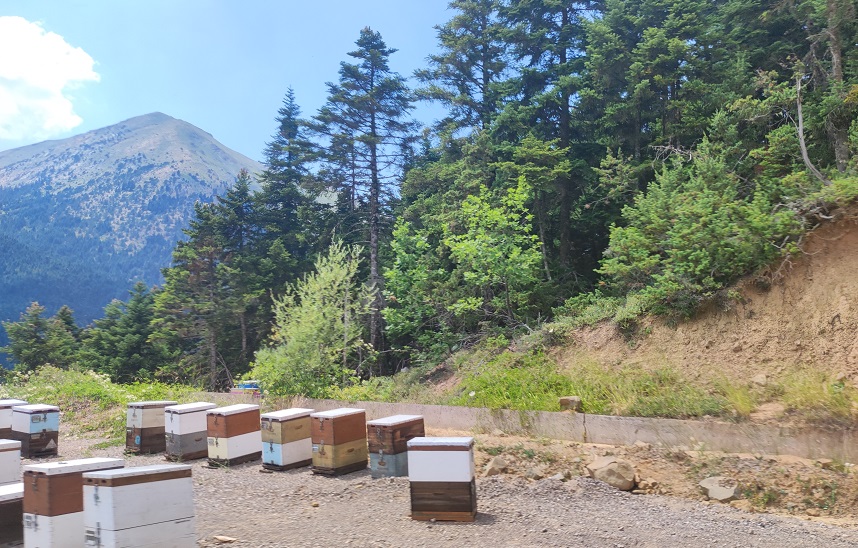Honey Produced in Forests and Meadows

This post is also available in:
This post is also available in:
![]() Español (Spanish)
Español (Spanish) ![]() Français (French)
Français (French) ![]() Ελληνικά (Greek)
Ελληνικά (Greek) ![]() Português (Portuguese (Brazil))
Português (Portuguese (Brazil))
What is forest honey?
There are two ways to use the term “Forest Honey”.
Forest honey is a type of honey produced by bees by collecting nectar from a diverse range of flowers, trees (chestnuts, beeches, and oaks) and sugary secretions (pines, spruces, firs) usually found in dense forests and high altitudes. The flavor and color of forest honey can vary widely, from one region and year to another, depending on the types of plants and trees where the bees collect nectar. Forest honey is generally considered a high-quality honey due to its unique flavor profile, which has a slightly rich woody flavor, and the presence of beneficial compounds derived from the plants found in forested areas.
The other way is when we use it as a category for the honey types that are produced in the forest, such as:
Chestnut Honey
Chestnut honey is produced mainly in Europe and Asia, in areas where chestnut trees are abundant. It is a special case of honey. The reason is that although it is considered to be a flower honey, it has the characteristics of a honeydew honey as it is produced both from the nectar of the chestnut tree blossoms and from the honeydew secretions produced by the aphid Myzocallis castanicola, which settles on the lower surface of the leaves of the chestnut tree. It is known for its antibacterial properties and is believed to have several health benefits, such as reducing inflammation and helping to alleviate respiratory problems. Additionally, it promotes blood circulation and has astringent and disinfectant properties for the urinary tract.
Taste: Strong, bold flavor that is slightly bitter and nutty. Sometimes it can outweigh the flavor of other honeys.
Aroma: Distinctive, intense aroma
Color: Dark amber and sometimes can be reddish due to the honeydew.
Crystallization: This honey crystallizes after 1-2 years
Pine honey
Pine honey is a type of honeydew honey that is produced by bees that collect honeydew (sugary secretions) from a scale insect species called Marchalina hellenica, which lives on certain pine trees. Pine honey is rich specifically in ash content, minerals and metals. Pine honey is particularly popular in Mediterranean countries. However, it is less widely available than other types of honey due to its specific production process and the limited availability of pine trees in certain regions. Below you can find some characteristics of pine honey:
Flavor: Pine honey has a strong, resinous flavor that is unique and distinct from other types of honey. It can have a slightly bitter aftertaste.
Color: Pine honey is typically dark in color, ranging from amber to reddish-brown.
Crystallization: Due to the low glucose content is not easy to crystallize. It can remain fluid for more than one and a half a year.

Hives placed in a pine forest
Fir Honey
Fir honey is a honeydew honey produced by bees that collect honeydew (sugary secretions) from a scale insect species called Physokermes hemicryphus. Fir honey is produced in areas where fir trees grow, such as the forests of Europe and North America.
In Greece, there are different categories of fir honey. Most fir honey is produced in areas with fir trees (Abies cephalonica). However, there is one special type with a specific name. Fir honey from Arcadia (Peloponnese) stands out because of the creamy sheen created internally and is called “Menalou Vanilia fir honey” (PDO). It contains at least 80% honey from the black mountain fir; the rest will be flower honey produced in the region. It has a special taste similar to vanilla. It has very low percentages of sugars and is rich in enzymes, proteins, vitamins and trace elements, such as iron, phosphorus, potassium and magnesium. It is also known as pearl honey. Its production is rare and costly as most honeycombs are destroyed during honey extraction.
Taste: Special, resinous
Aroma: Not strong, but distinctive aroma.
Colour: “Menalou Vanilia fir honey” is a creamy sheen. Generally, it has bright colour in some areas and darker in others.
Crystallisation: Its low glucose content helps it not to crystallise.
What is Wildflower Honey?
Wildflower honey is a multifloral honey made by bees that collect nectar from a variety of wildflowers. This honey has a complex flavour profile and can vary in colour depending on the region and the types of flowers that exist in the area. It is more widely available than other types of honey.
Taste: It has a distinctly sweet flavour
Aroma: Light.
Colour: Depending on the flowers the nectar was collected, it has a light amber colour
Crystallisation: It has a high glucose content; therefore, it is quite easy to crystallise

Hives placed into a wildflower field
References
Rybak-Chmielewska, H., & Tomasik, P. (2003). Honey. Tomasik, P. Chemical and functional properties of food saccharides. Boca Raton: CRC, 73-80.
https://nnc.gov.ph/regional-offices/mindanao/region-ix-zamboanga-peninsula/9879-what-you-should-know-about-honeycomb
Ahmed S Mesallam, Mohammad I El-Shaarawy, Quality attributes of honey in Saudi Arabia, Food Chemistry, Volume 25, Issue 1, 1987, Pages 1-11, ISSN 0308-8146, https://doi.org/10.1016/0308-8146(87)90049-5.
Interesting Facts About Honey – Honey nutritional value
Which Factors Affect Honey Quality
Honey Types and their Characteristics
Honey Produced in Forests and Meadows








































































